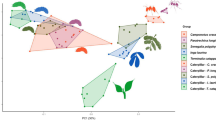Summary
We investigated the food preferences of captive snowshoc hares (Lepus americanus) in winter to test three hypotheses proposed to explain food choices by hares: (1) that food choice is related to the protein content of twigs; 92) that defensive chemicals present in twigs are negatively correlated with hare food preferences; and (3) that hares eat less-preferred but protein-rich twigs when their diet is buffered by large amounts of palatable food. Hares exhibited striking and consistent preferences for different species and, in general, preferred mature twigs to juvenile growth stages. Preferences across species among mature twigs were not, however, the same as preferences for juvenile growth stages across species. None of the three hypotheses adequately explained food choice by hares. Hares did not (1) select twigs that were high in protein content. They also did not (2) consistently select twigs that were low in resins or phenols. Finally (3), hares generally ate less, not more of non-preferred twigs in the presence of a protein and energy rich alternative food, commercial rabbit chow. Food preferences of hares must presumably have some chemical basis, but no simple theory has yet explained what this is. We suggest that hares may not be under severe dietary constraints imposed by chemical defenses in winter.
Similar content being viewed by others
References
Anonymous (1975) Methods of analysis of the Association of Official Analytical Chemists. 12th Edition. Horwitz W (ed) AOAC Publication, Washington. p 928
Bookhout TA (1965) The snowshoe hare in Upper Michigan: its biology and feeding coactions with white-tailed deer. Mich Dept Conserv Res Develop Rep No 38, 1–198
Bryant JP (1981 a) Phytochemical deterrence of snowshoe hare browsing by adventitious shoots of four Alaskan trees. Science 213:889–890
Bryant JP (1981 b) The regulation of snowshoe hare feeding behaviour during winter by plant anti-herbivore chemistry. In: Myers K, MacInnes CD (eds) Proceedings of the World Lagomorph Conference, August 12–16, 1979. Guelph Unversity Press, pp 720–731
Bryant JP, Kuropat P (1980) Selection of winter forage by subarctic browsing vertebrates: the role of plant chemistry. Ann Rev Ecol Syst 11:261–285
Concon JM, Soltess D (1973) Rapid micro-kjeldahl digestion of cereal grains and other biological materials. Anal Biochem 53:35–41
Dodds DG (1960) Food competition and range relationships of moose and snowshoe hare in Newfoundland. J Wildl Manage 24:52–60
Farentinos RC, Capretta PT, Kepret RE, Littlefield VM (1981) Selective herbivory in tassle-eared squirrels: roles of monoterpenes in ponderosa pines chosen as feeding trees. Science 213:1273–1275
Haukioja E (1980) On the role of plant defeces in the fluctuation of herbivore populations. Oikos 35:202–213
Haukioja E, Hakala T (1975) Herbivore cycles and periodic outbreaks. Formulation of a general hypothesis. Rep Kevo Subarctic Res Stat 12:1–9
Keith LB (1974) Some features of population dynamics in mammals. Proc Int Congr Game Biol 11:17–58
Klein DR (1977) Winter food preferences of snowshoe hares (Lepus americanus) in Interior Alaska. Proc Int Congr Game Biol 13:266–275
Lindlof B, Lindstrom E, Pehrson A (1974) Nutrient content in relation to food preferred by mountain hare. J Wildl Manage 38:875–879
Pease JL, Vowles RH, Keith LB (1979) Interaction of snowshoe hares and woody vegetation. J Wildl Manage 43:43–60
Pehrson A (1981) Winter food consumption and digestability in caged mountain hares In: Myers K, MacInnes CD (eds) Proceedings of the World Lagomorph Conference, August 12–16, 1979. Guelph University Press, pp 732–742
Pyke GH, Pulliam HR, Charnov EL (1977) Optimal foraging: a selective review of theory and tests. Q Rev Biol 52:137–154
Rosenthal GA, Janzen DH (eds) (1979) Herbivores: their interaction with secondary plant metabolites. Academic Press, NY, pp 718
Sinclair ARE, Krebs CJ, Smith JNM (1982) Diet quality and food limitation in herbivores: the case of the snowshoe hare. Can J Zool 60:889–897
Swain T, Goldstein JL (1964) The quantitative analysis of phenolic compounds. In: Pridham JB (ed) Methods in polyphenol chemistry. MacMillan, NY, pp 131–146
Telfer ES (1972) Browse selection by deer and hares. J Wildl Manage 36:1344–1349
Wolff JO (1978) Food habits of snowshoe hares in Interior Alaska. J Wildl Manage 42:148–153
Author information
Authors and Affiliations
Rights and permissions
About this article
Cite this article
Sinclair, A.R.E., Smith, N.M. Do plant secondary compounds determine feeding preferences of snowshoe hares?. Oecologia 61, 403–410 (1984). https://doi.org/10.1007/BF00379643
Received:
Issue Date:
DOI: https://doi.org/10.1007/BF00379643




